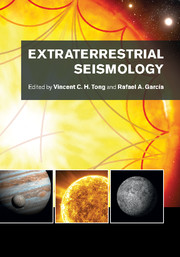Book contents
- Frontmatter
- Contents
- List of contributors
- Preface
- Acknowledgements
- List of abbreviations
- Planetary seismology: High risk, high return
- A bright outlook for helio- and asteroseismology
- Part I Observation and space missions
- Part II Data and physical parameters
- Part III Modeling approaches
- Part IV Discoveries of physical structures and processes
- Part V Interdisciplinary research involving planetary and astrophysical sciences
- 16 Diskoseismology of accretion disks
- 17 Numerical simulations of magnetoconvection and helioseismology
- 18 Impact seismology on terrestrial and giant planets
- 19 Angular momentum transport in stars: From short to long time scales
- 20 From the Sun to the distant stars, and back: Future research directions
- 21 Stellar dynamics: Rotation, convection, and magnetic fields
- 22 Sunquakes: Helioseismic response to solar flares
- 23 Seismic waves in small bodies: Sources and propagation
- Part VI Interdisciplinary research involving terrestrial seismology
- References
- Index
23 - Seismic waves in small bodies: Sources and propagation
from Part V - Interdisciplinary research involving planetary and astrophysical sciences
Published online by Cambridge University Press: 05 July 2015
- Frontmatter
- Contents
- List of contributors
- Preface
- Acknowledgements
- List of abbreviations
- Planetary seismology: High risk, high return
- A bright outlook for helio- and asteroseismology
- Part I Observation and space missions
- Part II Data and physical parameters
- Part III Modeling approaches
- Part IV Discoveries of physical structures and processes
- Part V Interdisciplinary research involving planetary and astrophysical sciences
- 16 Diskoseismology of accretion disks
- 17 Numerical simulations of magnetoconvection and helioseismology
- 18 Impact seismology on terrestrial and giant planets
- 19 Angular momentum transport in stars: From short to long time scales
- 20 From the Sun to the distant stars, and back: Future research directions
- 21 Stellar dynamics: Rotation, convection, and magnetic fields
- 22 Sunquakes: Helioseismic response to solar flares
- 23 Seismic waves in small bodies: Sources and propagation
- Part VI Interdisciplinary research involving terrestrial seismology
- References
- Index
Summary
Our Solar System is full of small bodies. The planets occupy an obvious role as the beautiful heavyweights, but smaller bodies are found throughout the Solar System in the form of asteroids, comet nuclei, and moons of Mars and the outer giants. Even Pluto has multiple moons. In spite of their abundance, there is not a large amount of mass in small bodies. An estimate for the mass of all the objects in the main belt puts it at around 4% the mass of the Moon (Krasinsky et al., 2002). Though many of their properties can be understood by looking at the surface and from surface samples, there are many questions that require looking inside the body.
For example, a central question of the bodies' origin and evolution is whether the asteroid or comet is an accretion of small objects into something larger, or is it a small piece of an originally larger object. An important clue to answering this question is the interior structure of the asteroid or comet nuclei. Being able to look inside would allow us to see the structure and whether the object is one solid piece, a small number of large pieces, or a lot of small objects held loosely together (the oft referred to “rubble pile”). In addition, understanding the interior structure is important if we want to move an asteroid or a comet nucleus, either for engineering reasons or to prevent one from striking Earth.
There are two ways of looking inside an object. Electromagnetic radiation or high-energy particles is one approach, which will not be discussed here save to mention that the power requirements are large and penetration depths of things such as “ground-penetrating radar” are not large. The second approach is to use mechanical waves propagating through the body, i.e., seismology.
The many successes of seismology have been described in the chapters in this book.
- Type
- Chapter
- Information
- Extraterrestrial Seismology , pp. 323 - 338Publisher: Cambridge University PressPrint publication year: 2015



